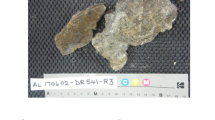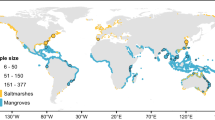Abstract
We report here extreme 13C enrichments in the dissolved inorganic carbon pool (ΣCO2) in evaporating brines. These enrichments may influence the interpretation of the stable carbon isotope record of both inorganic and organic carbon deposited in saline environments. Carbon isotope values of ΣCO2 respond to types of carbonate inputs, rate of exchange with the atmospheric CO2 and to biological effects1,2. δ13C values of up to +14‰, (all values are reported here with respect to the PDB standard) for ΣCO2 from anoxic waters have been reported where methane production by CO2 reducing bacteria occurs3. We document an abiotic effect in evaporating brines which resulted in 13C enrichments of up to +16.5‰) in natural conditions (solar evaporation ponds used for potash production) and up to +34.9‰ in laboratory evaporation experiments, the most enriched δ13C values reported to date in oxic conditions. These extreme enrichments may result from a non-equilibrium gas-transfer isotope fractionation.
This is a preview of subscription content, access via your institution
Access options
Subscribe to this journal
Receive 51 print issues and online access
$199.00 per year
only $3.90 per issue
Buy this article
- Purchase on Springer Link
- Instant access to full article PDF
Prices may be subject to local taxes which are calculated during checkout
Similar content being viewed by others
References
Turner, J. V., Fritz, P., Karrow, P. F. & Warner, B. G. Can. J. Earth Sci. 20, 599–613 (1983).
Rounick, J. S. & James, M. R. Limnol. Oceanogr. 29, 386–389 (1984).
Stiller, M. & Magaritz, M. Limnol. Oceanogr. 19, 849–853 (1974).
Epstein, J. A. Hydrometallurgy 2, 572–576 (1976).
Carpenter, J. H. Limnol. Oceanogr. 10, 141–144 (1965).
Gat, J. in Stable Isotope Hydrology, 21–33 (IAEA, Vienna, 1981).
Mook, W. G., Bommerson, J. C. & Staverman, W. H. Earth planet. Sei. Lett. 22, 169–176 (1974).
Schonfeld, I. & Held, S. Isr. Atom. Energy Comm. IA-1061 (1965).
Sass, E. & Ben-Yaacov, S. Mar. Chem. 5, 183–199 (1977).
Gat, J. R. Earth planet. Sci. Lett. 71, 361–376 (1984).
Katz, A., Kolodny, Y. & Nissenbaum, A. Geochim. cosmochim. Acta 41, 1609–1626 (1977).
Schidlowski, M. & Matzigkeit, U. Naturwissenschaften 71, 303–308 (1984).
Steinhorn, I. Isr. J. Earth Sci. 29, 191–196 (1980).
Author information
Authors and Affiliations
Rights and permissions
About this article
Cite this article
Stiller, M., Rounick, J. & Shasha, S. Extreme carbon-isotope enrichments in evaporating brines. Nature 316, 434–435 (1985). https://doi.org/10.1038/316434a0
Received:
Accepted:
Issue Date:
DOI: https://doi.org/10.1038/316434a0
This article is cited by
-
Sustained and intensified lacustrine methane cycling during Early Permian climate warming
Nature Communications (2022)
-
A laboratory study investigating the effects of dilution by precipitation on dissolved inorganic carbon and stable isotope evolution in surface waters
Environmental Science and Pollution Research (2018)
-
Controls on the origin and cycling of riverine dissolved inorganic carbon in the Brazos River, Texas
Biogeochemistry (2011)
-
Particulate organic and dissolved inorganic carbon stable isotopic compositions in Taylor Valley lakes, Antarctica: the effect of legacy
Hydrobiologia (2009)
-
Carbon isotope anomaly in marbles associated with eclogites from the Dabie Mountains
Chinese Science Bulletin (1998)
Comments
By submitting a comment you agree to abide by our Terms and Community Guidelines. If you find something abusive or that does not comply with our terms or guidelines please flag it as inappropriate.



